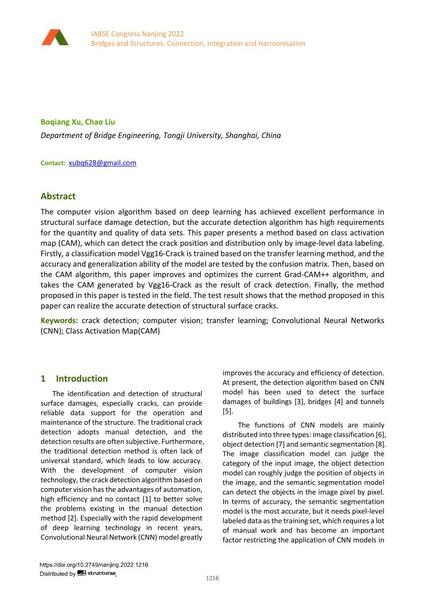Detection Algorithm of Structural Surface Cracks Based on Class Activation Map

|
|
|||||||||||
Bibliografische Angaben
| Autor(en): |
Boqiang Xu
(Department of Bridge Engineering, Tongji University, Shanghai, China)
Chao Liu (Department of Bridge Engineering, Tongji University, Shanghai, China) |
||||
|---|---|---|---|---|---|
| Medium: | Tagungsbeitrag | ||||
| Sprache(n): | Englisch | ||||
| Tagung: | IABSE Congress: Bridges and Structures: Connection, Integration and Harmonisation, Nanjing, People's Republic of China, 21-23 September 2022 | ||||
| Veröffentlicht in: | IABSE Congress Nanjing 2022 | ||||
|
|||||
| Seite(n): | 1216-1223 | ||||
| Anzahl der Seiten (im PDF): | 8 | ||||
| DOI: | 10.2749/nanjing.2022.1216 | ||||
| Abstrakt: |
The computer vision algorithm based on deep learning has achieved excellent performance in structural surface damage detection, but the accurate detection algorithm has high requirements for the quantity and quality of data sets. This paper presents a method based on class activation map (CAM), which can detect the crack position and distribution only by image-level data labeling. Firstly, a classification model Vgg16-Crack is trained based on the transfer learning method, and the accuracy and generalization ability of the model are tested by the confusion matrix. Then, based on the CAM algorithm, this paper improves and optimizes the current Grad-CAM++ algorithm, and takes the CAM generated by Vgg16-Crack as the result of crack detection. Finally, the method proposed in this paper is tested in the field. The test result shows that the method proposed in this paper can realize the accurate detection of structural surface cracks. |
||||
| Stichwörter: |
Risserkennung
|
||||
| Copyright: | © 2022 International Association for Bridge and Structural Engineering (IABSE) | ||||
| Lizenz: | Die Urheberrechte (Copyright) für dieses Werk sind rechtlich geschützt. Es darf nicht ohne die Zustimmung des Autors/der Autorin oder Rechteinhabers/-in weiter benutzt werden. |
||||
